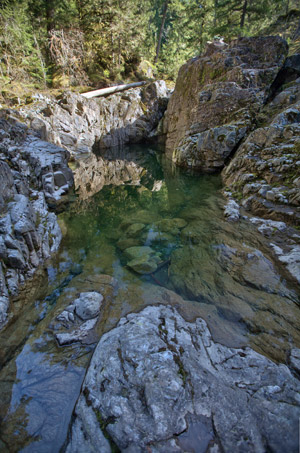
Focus Stacking in Photoshop VS F/22 for Landscapes

I heard about focus stacking a few years ago but never took the time to experiment with it. A recent conversation with a fellow photographer about ’tilt-shift’ lenses prompted me to explore this fascinating technique of achieving full focus throughout the entire image (like my shot above), so I decided to make a very redneck and unscientific experiment.
What is Focus Stacking?
If you haven’t heard about focus stacking let me explain the technique as simply as I can.
You know that super sharp focus that you see in images with very shallow depth of field, such as with an f/2.8 aperture setting is used in a portrait? Well, imagine if you could achieve that same sharp focus in your entire image without the blurred (bokeh) areas. Macro photographers use this technique to great effect so why shouldn’t landscape photographers?
We all know that to get every part of your landscape image in focus all you have to do is wind that aperture to it’s narrowest ‘infinity’ setting (most commonly f/22) but does it deliver the same sharpness as lets say f/8?
The answer is no way, there is a difference due to the phenomenon of light diffraction. How much of a difference does it make if you’re NOT printing out 4ft wide gallery prints? Turns out it doesn’t make a great deal of difference if you only plan on displaying your images online.
If however, you plan on creating medium to large prints you’re going to want to harness every bit of sharpness you can possibly get and that is where focus stacking in Photoshop is a life saver. If you’ve ever used Photoshops pano stitching tool you’ll know that it can sometimes deliver sketchy results but the process of focus stacking yielded more stable results first time round for me.
For a proper explanation of what focus stacking is and how it works read this wikipedia article.
The Comparison
Here are two images of the same composition. The one on the left uses f/22 and no focus stacking. The one on the right uses f/2.8 with 4 focus stacked exposures.
At first glance there is not much difference in overall sharpness. The ‘stacked focus’ image on the right has a slight bokeh in the trees of the top right so I probably should have taken one more exposure with concentrated focus on that area. You’ll also see some photoshop artifacts in the edges of the image which can either be cropped or cloned out.
Even when zooming in to 100%, the sharply focused parts of both images are comparable with neither really gaining the edge.
The Sweet spot of your lens
I’ve read countless forum discussions on this topic and it’s widely believed that all lenses have a sweet spot that gives maximum sharpness. The general idea is that it’s somewhere between f/8 and f/16. Perhaps I used the wrong aperture in this test so I’ll keep trying and let you know if I do find the sweet spot of my 16-35mm lens. (Update – f/11 seems to give the sharpest results in most lighting situations).
Is it worth the effort?
This was only my third attempt at focus stacking so I’ve got some improving to do but my first impression is that it’s not an ideal shooting method for all landscape situations. It takes time to get all those multiple shots lined up especially if you’re doing HDR and panoramics.
It’s also quite a lot of work in photoshop so if you’re not a fan of image editing you might want to stick with traditional focus options.
I do however like having lots of control and being able to control specific areas of focus in post production is a nice luxury. My advice would be to use both methods but only if you have the time. If the shot you’re after exists only for a few seconds you should forget focus stacking.
Pros of Focus Stacking
- Finer Control of focus and depth of field.
- Faster shutter speeds
- Less light diffraction
Cons of Focus Stacking
- Time consuming to shoot as the light changes
- Time consuming in post production
- You’ll have to crop the image to remove Photoshop artifacts
Feel free to download the full sized images and study them in detail. Post a comment and let us know you think.
How to do Focus Stacking in Photoshop
There are lots of video tutorials on the choob and I found this one to be the most relevant for landscape photography focus stacking.



For me the payoff in focus control doesn’t justify the added time it takes to shoot let alone process in post.
Great tip!
I’ve been doing this for the last few months, and the results are nothing short of amazing.